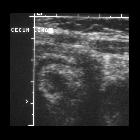CMV gastroenteritis


Cytomegalovirus (CMV) infection of the gastrointestinal tract is usually seen in patients who are severely immunocompromised, such as solid organ transplantation and is common in HIV/AIDS, and is, in fact, the most common gastrointestinal manifestation of AIDS .
Epidemiology
Approximately 30% of all patients with AIDS will at some point in their illness develop a cytomegalovirus infection of the gastrointestinal tract . This usually occurs when CD4+ counts drop to below 100 mm .
In patients with solid organ transplants, CMV colitis is most frequently seen in those with heart/heart-lung transplants (25-40%) and liver transplants (30%) .
Although rare, CMV colitis may occur in immunocompetent patients. A meta-analysis of immunocompetent hosts with non-immune modulating comorbidities found the average age of infection was 70 years . Of these, 55% of infections were community acquired, 31% resolved spontaneously and 22% required colectomy .
Clinical presentation
Clinical presentation depends on the site of infection, which can extend from the esophagus down to the rectum. The colon and rectum are more frequently involved . In homosexual men with AIDS, this is especially the case with the descending and rectosigmoid most commonly involved, presumably due to direct inoculation during anal intercourse .
In CMV esophagitis, patients typically have retrosternal pain and odynophagia.
Patients with CMV enterocolitis most often present with diarrhea, fever and weight loss, abdominal pain and hematochezia . It is important to note that in up to a third of patients, diarrhea is not a prominent feature . If the rectum is involved tenesmus may also be present. Transmural involvement does occur and signs and symptoms of peritonitis may develop, although it is important to note that due to the poor immune response in these patients, signs of peritonitis may be minimal or absent . In approximately a quarter of patients, CMV colitis can be the first manifestation of HIV/AIDS .
Pathology
Cytomegalovirus (CMV) is a herpesvirus found in a large proportion of individuals (30-100%) . Primary infection is usually asymptomatic. As is the case with other herpes viruses, the virus remains dormant, and once a patient is severely immunocompromised reactivation occurs. Mucosal damage is believed to be due to a vasculitis with focal regions of ulceration representing ischemic damage .
The histological finding of large eosinophilic, intranucelear inclusion bodies with surrounding halo and cytomegalic cells of 2-4 times the normal size is the gold standard for diagnosing CMV colitis .
Radiographic features
Barium studies
CMV esophagitis
Small well-circumscribed ulcers are present, with the mucosa between them appearing normal. Larger (~2 cm) superficial mid-esophageal ulcers are said to be relatively characteristic of CMV esophagitis . Deep ulceration is uncommon .
CMV gastritis
Typically there is involvement of the gastric antrum. Fluoroscopy shows a nodular mucosal pattern with luminal narrowing .
CT
CT is particularly useful in CMV enterocolitis. The appearances are somewhat similar to that of inflammatory bowel disease, with mural thickening and surrounding stranding. Unlike IBD, the thickening is often patchy and not circumferential . Ascites is seen in almost half of cases . Both diffuse and segmental patterns are described . In some instances, the appearances are essentially normal and biopsy is therefore still required when clinical symptoms are suspicious.
Involvement of the small bowel is less frequent, seen in only 42% of cases .
Lymph node enlargement is usually not present .
Perforation has the usual imaging hallmarks of free intraperitoneal fluid and gas.
Treatment and prognosis
When suspected the diagnosis should be confirmed by endoscopy and biopsy.
Intravenous treatment with ganciclovir results in the complete response in 90% of cases . Failing this, further treatment with foscarnet or cidofovir has been shown to improve symptoms .
Patients who develop intestinal perforation and peritonitis or toxic megacolon require surgical intervention with resection. In some cases of refractory CMV colitis, elective colectomy has also been advocated and performed .
Differential diagnosis
The differential diagnosis depends on the location.
CMV esophagitis
- idiopathic esophagitis of HIV: can appear similar
- herpes esophagitis: can appear similar
- candida esophagitis
CMV gastritis
CMV enteritis and colitis
- inflammatory bowel disease
- infective colitis from other infective agents
- pseudomembranous colitis
- ischemic colitis
- graft versus host disease
- typhlitis
Siehe auch:
und weiter:

 Assoziationen und Differentialdiagnosen zu Cytomegalievirus Enterokolitis:
Assoziationen und Differentialdiagnosen zu Cytomegalievirus Enterokolitis:

